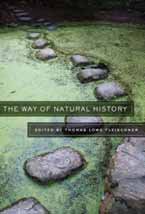SEJournal Online is the digital news magazine of the Society of Environmental Journalists. Learn more about SEJournal Online, including submission, subscription and advertising information.

BookShelf
The Way of Natural History
Edited by Thomas Lowe Fleischner
Trinity University Press, $16.95 (paperback)
Reviewed by NANCY BARON
When novelist Jonathan Franzen finds himself checking his email every 10 minutes, biting off chaws of tobacco, gulping drinks, and obsessively playing computer solitaire, he finds relief in nature — particularly watching birds. “To glimpse a rare bird somehow persisting in its life of breeding and feeding is an enduringly transcendent delight.”
That’s the theme of a new compendium of personal and revealing essays, showing he’s not alone in finding relief in the natural world.
The Way of Natural History features 20 authors, including scientists, poets, a rock guitarist, a professional gardener — even a former convict — who explore the importance of paying attention to the bigger world outside our own heads.
“What we choose to focus it on has enormous consequences,” writes editor Thomas Lowe Fleischner. “And what we choose to look at and to listen to, these choices change the world.”
Reviving the study and appreciation of natural history is a growing social movement called the Natural History Initiative instigated by a network of scientists and writers and artists, many of whom are authors featured in this book published by Trinity University Press.
The point is that while there is no “one way” to relate to nature, it is something we need to soothe our personal lives, not to mention help address societal and environmental woes.
For our ancestors, attentiveness to nature was a matter of survival, knowing the migratory movements of animals, and where and when to find food plants.
This intimate knowledge was understood to be essential.
It still is. But most of us have forgotten, or never had the chance to experience it.
The reasons are many: modern lives with little free time for play and exploration, the expanding role of technology, narrowly focused social media — all can distract from the natural world around us and lead to “nature-deficit disorder.”
Writers in this book argue that connection to a larger community of neighbors — one that takes into account animals, plants, pollinators, producers, predators and decomposers — is essential to environmental well-being.
Concern about nature-deficit disorder has caught the attention of the National Science Foundation. It has funded initiatives such as the Long Term Ecological Reflection project, which is linked to the Long Term Ecological Research (LTER), a federal network of forests, deserts and other representative habitats under study.
Three of the essays in the books are part of this NSF-funded project, offering reflections on ever-changing nature and our relationship with it.
In some essays, scientists shatter their usual stiff, dispassionate stereotypes by showing tenderness for their research subjects.
Wolf researcher Christine Eisenberg’s essay, “Lessons from 763,” presents a clear case about why predators matter to healthy ecosystems. But it’s her intimacy with the animals and their lives that lingers.
“I cradle the sleeping wolf in my arms, keeping her warm against the morning frost, the way I held my daughters when they were small,” she writes. “However, anything but small, wolf number 763 is a sturdy, 80-pound, lactating female.”
Eisenberg names the wolf after her mentor Nina Leopold, and muses that the wolf, carrying her scent back to her den, links her forever to the pups. She sees these pups again as part of a team radio-collaring wolves in Glacier National Park. Her study of these wolves’ lives is interwoven with her explanation of how top predators create “more resilient ecosystems, help restore and maintain biodiversity, and help some of the damage we have done to the Earth.”
In a rollicking essay, “The Grounding of a Marine Biologist,” Paul Dayton of Scripps Institution of Oceanography writes of his early days exploring the natural history in the southwestern deserts and mountains. It has the feel of a Steinbeck novel, with life experiences shared with his brother, father and later his own children.
He points out that biologists who study nature are often dismissed as lightweights.
“Today young scholars are asked to study ecology without any sense of place, any understanding of the actual organisms living in real environments characterized by their important histories.”
As in many collections of essays, some are better written than others. But their insights or quirkiness make them all worthwhile.
Ken Lamberton wrote “Yard Birds” about his experiences behind bars in Arizona. He describes dark laps around the prison yard each evening. “Sprays of termites, nighthawk ballets, and even an abandoned pelican feather holding a slip of sky against its vane, are the air that fills my lungs.”
Ed Grumbine writes from China on a “natural history of dams.” Grumbine was recently described in Science as “an eco-guru,” advising Yunnan on environmental policy and the perils of unrestrained hydropower development.
Robert Michael Pyle is reminiscent of Mark Twain in both voice and appearance. He knows more about butterflies than any academic. In his essay, “A Nat’ral Histerrical Feller in an Unwondering Age,” he describes the sharp pleasure of recognizing a butterfly by its behavior and the sadness of how few others understand or care.
This eclectic collection has much to offer anyone who cares about the environment, sustainability, and, yes, nature.
Nancy Baron is the Science Outreach Director for COMPASS and author of Escape from the Ivory Tower, as well as the field guide Birds of the Pacific Northwest Coast.
From the quarterly newsletter SEJournal, Fall 2011 issue.












 Advertisement
Advertisement 



